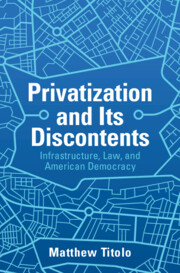Book contents
- Privatization and Its Discontents
- Privatization and Its Discontents
- Copyright page
- Dedication
- Contents
- Acknowledgments
- Introduction
- 1 Early Liberalism, Adam Smith, and the Seeds of the Infrastructural State
- 2 Forging the Infrastructural State
- 3 “A Wilderness of Turnpike Gates”
- 4 The Panic of 1837 and the Infrastructure Crash
- 5 “The Ground under Our Feet”
- 6 The Death of Laissez-Faire and the Rise of Infrastructure in the Cold War
- Conclusion
- Index
1 - Early Liberalism, Adam Smith, and the Seeds of the Infrastructural State
Published online by Cambridge University Press: 08 June 2023
- Privatization and Its Discontents
- Privatization and Its Discontents
- Copyright page
- Dedication
- Contents
- Acknowledgments
- Introduction
- 1 Early Liberalism, Adam Smith, and the Seeds of the Infrastructural State
- 2 Forging the Infrastructural State
- 3 “A Wilderness of Turnpike Gates”
- 4 The Panic of 1837 and the Infrastructure Crash
- 5 “The Ground under Our Feet”
- 6 The Death of Laissez-Faire and the Rise of Infrastructure in the Cold War
- Conclusion
- Index
Summary
The chapter uses Adam Smiths wealth of nations to complicate simple laissez-faire notions of economic development. Adam Smith argued that public works were crucial for economic development. Since they wouldnt always be provided by private firms there would need to be some government involvement. However, Smith argued that government waste and debt would continue to be risks of infrastructure, so he argued that infrastructure should be governed by cost-internalizing principles. Also, Adam Smith argued for natural monopoly, which would be exempt from market forces, which provided the groundwork for the idea of public utilities.
Keywords
- Type
- Chapter
- Information
- Privatization and Its DiscontentsInfrastructure, Law, and American Democracy, pp. 33 - 54Publisher: Cambridge University PressPrint publication year: 2023

